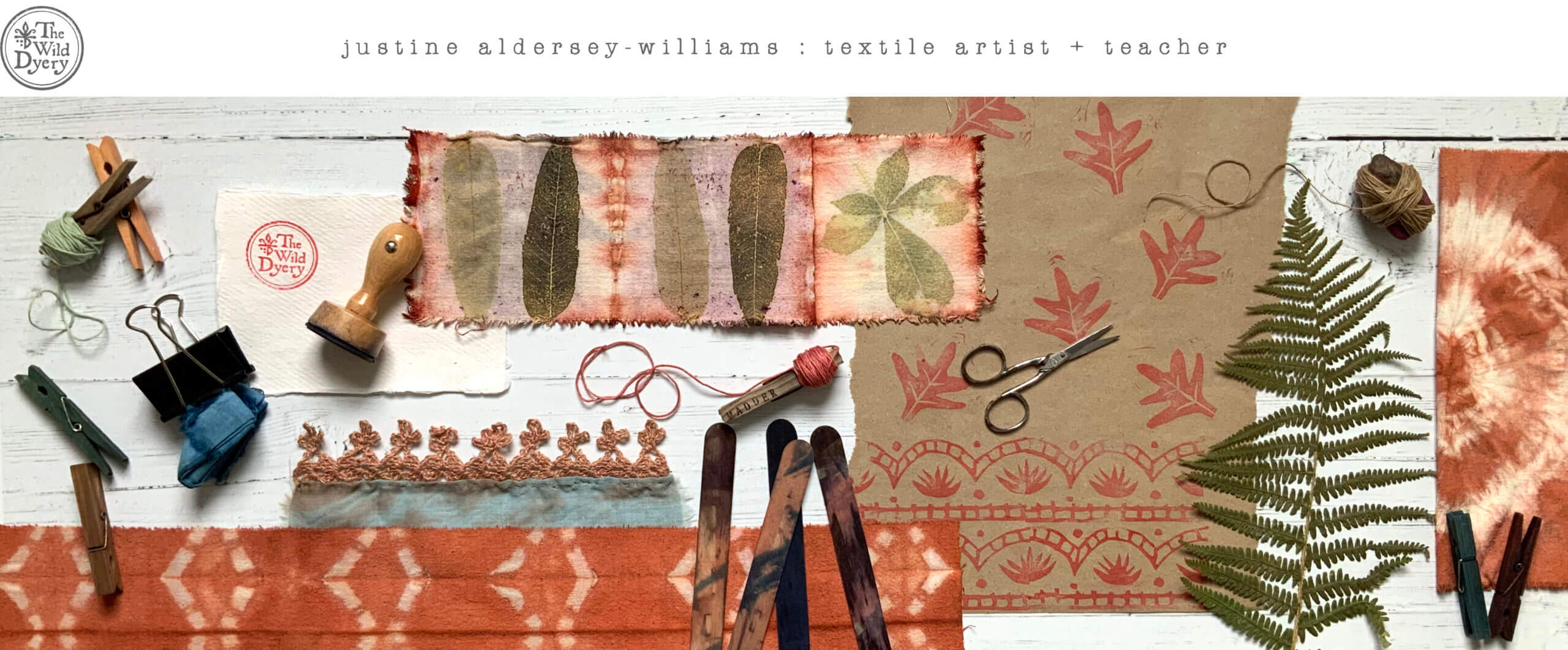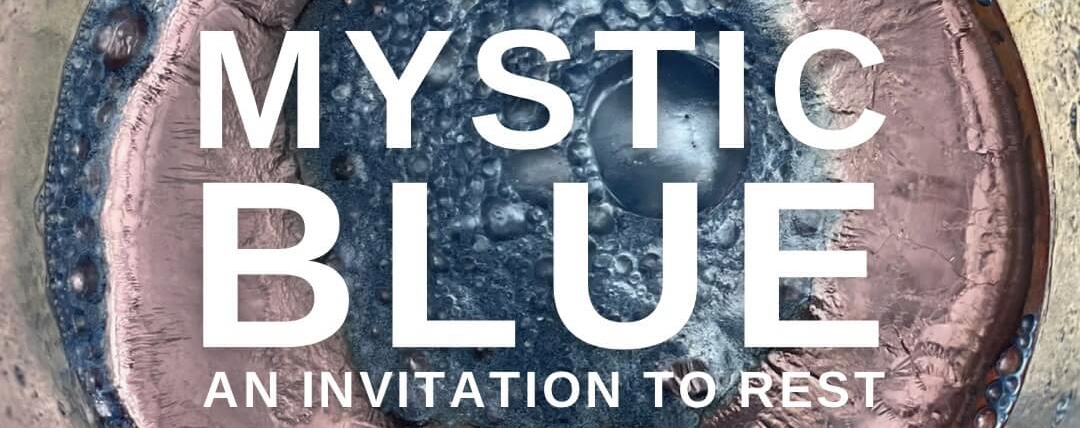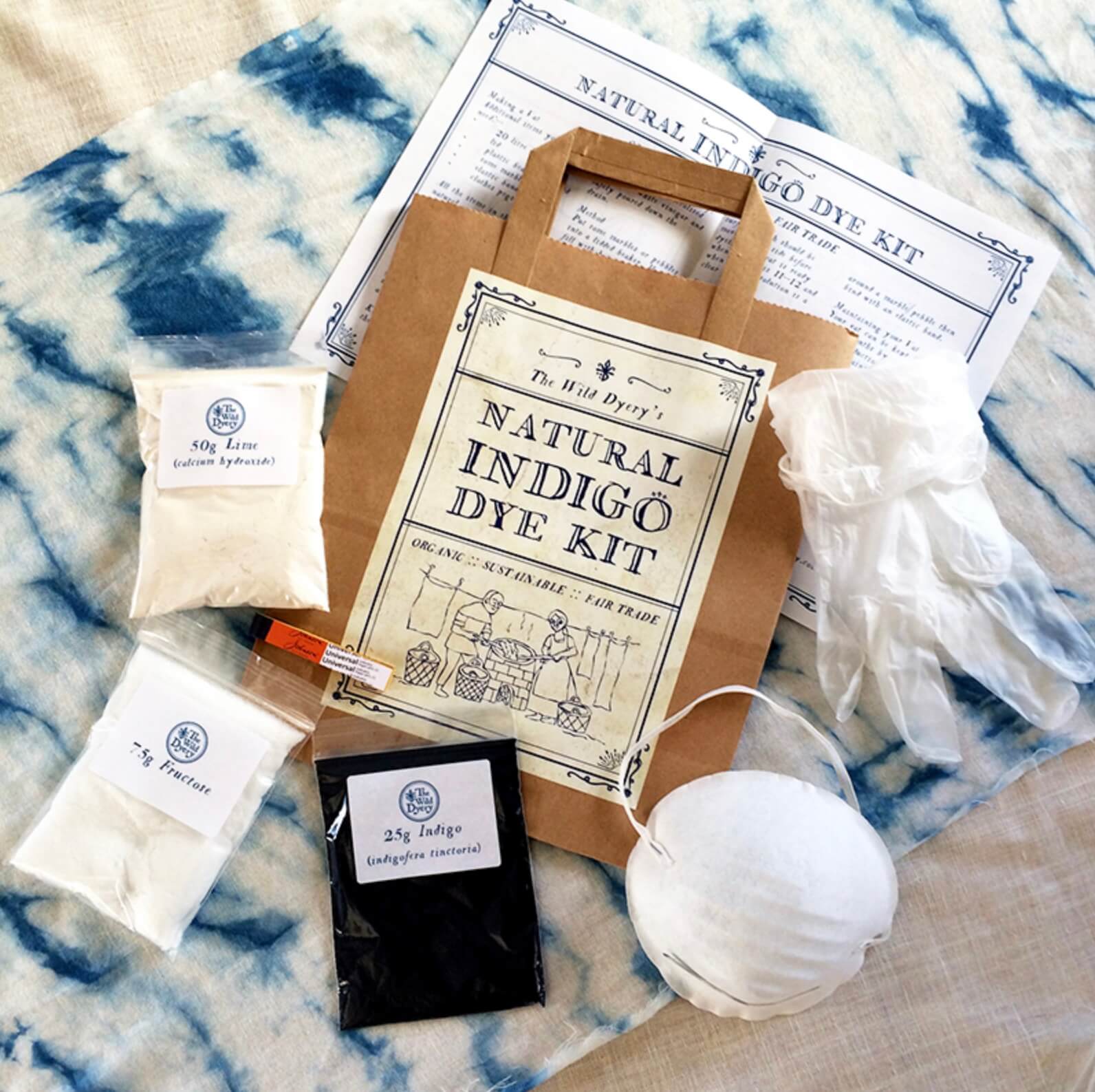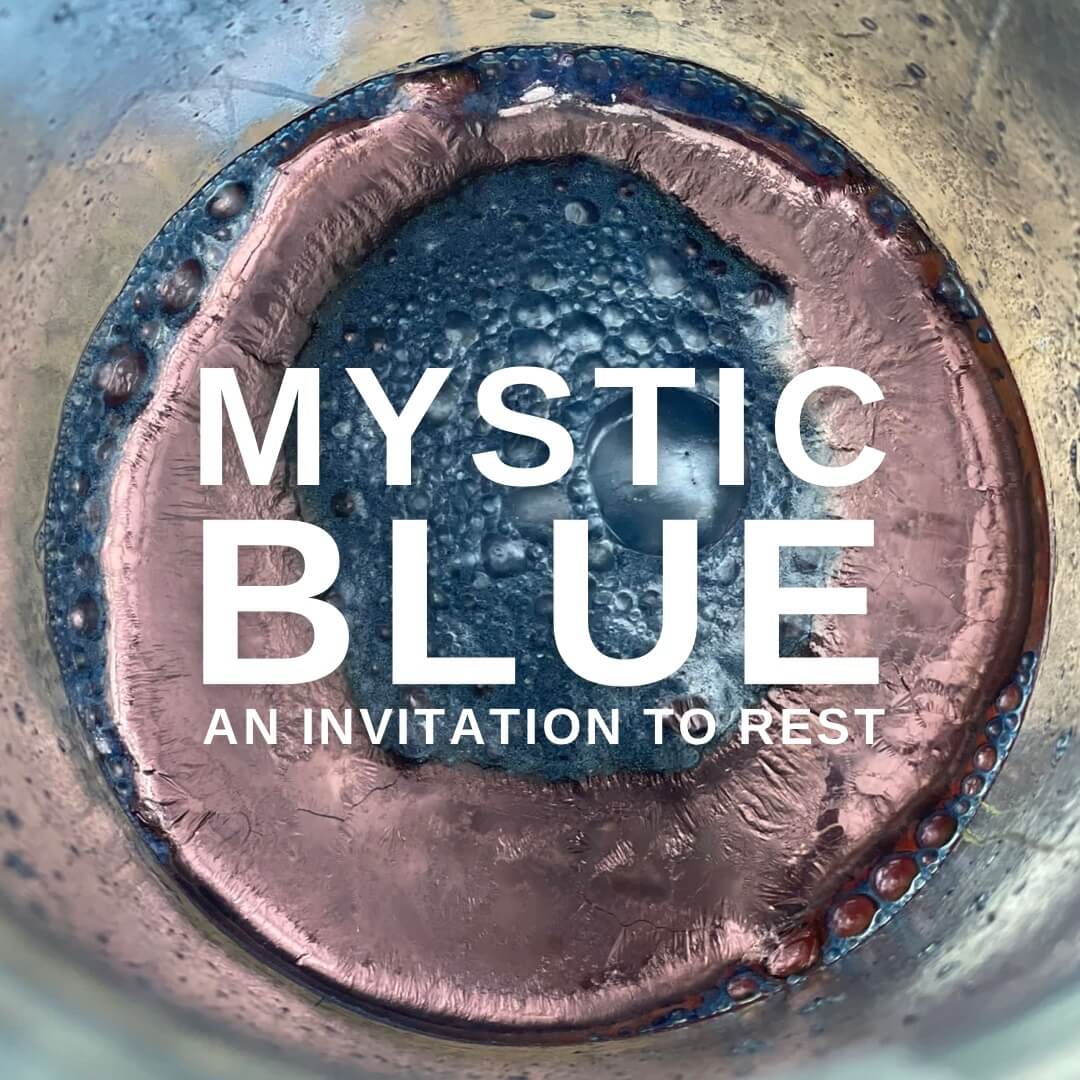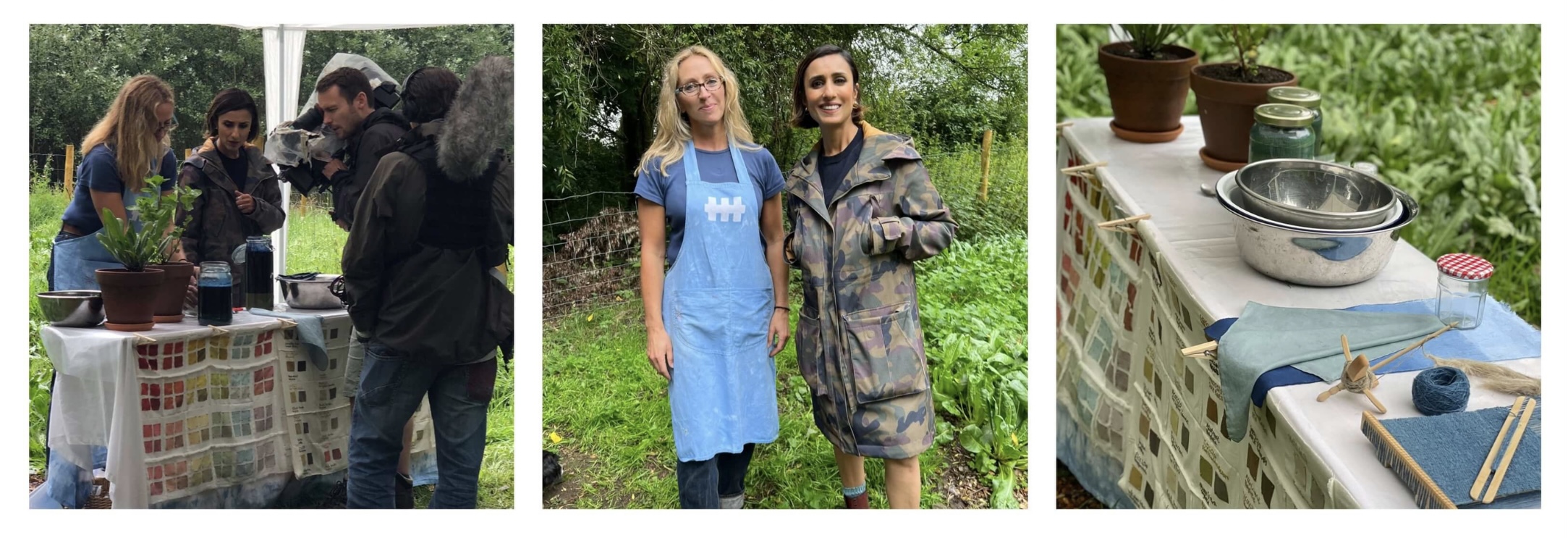
Having been featured in their magazine last April, in July I was asked by BBC1’s Countryfile programme to share my love of indigo in their ‘Field to Fashion’ episode. They’re featuring the Homegrown Homespun project that I co-founded with Patrick Grant and the SuperSlow Way team this Sunday on BBC1 at 5:15pm and wanted me to demonstrate how to get blue dye from green leaves.
Only those with experience of indigo yielding plants will understand what a challenge this was in a rainy field in Blackburn, but also a huge privilege and responsibility bringing this sacred alchemy to 6 million people!
I don’t remember exactly what I said during filming as I decided to undertake a high risk demo that resulted in some kind of out-of-body experience but in the spirit of passionate disruption, I hoped to be as provocative as possible. Due to time limitations I couldn’t tackle the many factors intersecting indigo dye practice - it’s colonialist history and spiritual associations alone would require a series in themselves. I’m also not sure which parts of my demo and chat with Anita Rani will make the cut so am documenting what I remember now with some of the other work I’ve contributed to the Indigo God/dess this year.
I am infinite sky. I am deepest ocean. I am the colour of God.
I attempted to distill the magic of a colour that’s mystified and enchanted humanity since the beginning of time into a 3 minute TV-friendly demo. The irony of this wasn’t lost on me and I wrestled with my conscience beforehand, arguing on the one hand that indigo requires devotion too sacred for exposing to the hungry ghosts* of capitalist pop-culture. Then on the other hand, understanding the potential good that could result from raising awareness of renewable dye with an audience of nature-lovers and possible future devotees.
In the end, I asked indigo Itself.
I’d shared an indigo-inspired ‘Earth Rests’ meditation (free invite above) with participants of my Growing Slow Textiles course two months before and had been repeatedly journeying into 'the zone' since then for guidance. During these mystic blue meditations I experienced a sense of deep faith in Indigo as a wise teacher and decided to accept that whatever worked during my trials would be an indication of what I should share publicly. I surrendered and let indigo decide what I said and did that day - after all, as the wonderful indigo expert Jenny Balfour-Paul has written in her books, indigo is considered 'the colour of God' by many cultures.
Stats and Magic
Bearing in mind the jeopardy of the demo I’d planned, I was reassured to know that my project partner, Patrick Grant of BBC1’s Great British Sewing Bee, would tell the majority of our Homegrown Homespun story. I promised him ‘stats and magic’!
Of all the dyes derived from fossil fuels, synthetic indigo is the most toxic:-
- The IPCC report states humanity must divest from fossil fuels with the United Nations predicting ‘societal collapse on a global scale due to breaching planetary boundaries’ by 2030 if we do not
- 150 billion items of clothing are manufactured each year, almost 70% of which are derived from fossil fuels
- 80,000 tonnes of synthetic indigo derived from crude oil was used globally in 2010 (Fibershed)
- The carcinogen aniline is a key ingredient in the production of synthetic indigo (Kingspin Show)
- Synthesising indigo requires a number of toxic chemicals, including cyanide and formaldehyde which harm human and environmental health (Tabby Kibugi)
- Textile dyes and treatments account for a fifth of all industrial water pollution (Ellen MacArthur Foundation)
- 72 dye chemicals are regularly released into the environment – 30 of which can’t be removed (Fibershed)
Meanwhile…
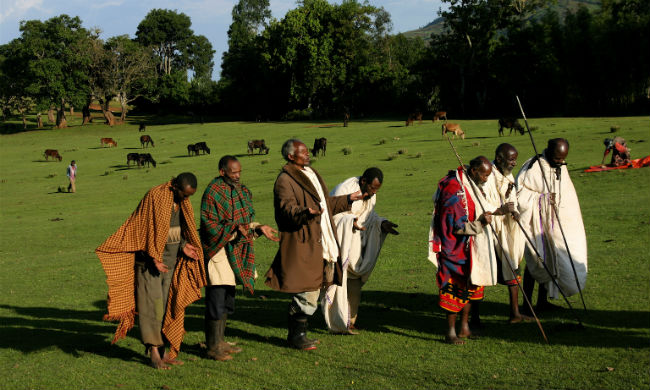
Comprising less than 5% of the world's population, indigenous people protect 80% of global biodiversity. - National Geographic
The most important fact that I hope made it into the edit is that crucially, indigenous people have not protected 80% of global biodiversity by following Western science. They’ve done this by developing deep, intuitive relationships with the more-than-human world through prayer, ritual and meditation.
As someone who’s happy to have been labelled a ‘hippie/treehugger/witch’ most of my life, this is both a comforting and distressing statistic. Of course, I’ve been severed from my indigeneity like the majority of people but have been devoted to studying earth-loving beliefs systems most of my life and am on my way home to my true nature which is nature.
We have the science about climate breakdown but this intellectualism somehow doesn't reach the heart and soul where real behavioural change happens. If my tone is conversational it’s because I’d like this message to be accessible to as many people as possible. Academic language can be a alienating form of elitism.
What I also find fascinating is that since the Industrial Revolution, most dye research and development has focussed on synthetics but while there are some fascinating academic studies into indigo dye, even the scientists admit they don't fully understand the science. This is where intuition comes in!
We urgently need to tune out of ecocidal brainwashing and tune in to the wisdom of nature. Awe, magic and mystery put smiles on faces and instantly engender greater connection, love and respect for our plant allies. I hope I manage to communicate this on Countryfile.
There’s nothing alternative about respecting your life-support system.
Indigo Demo
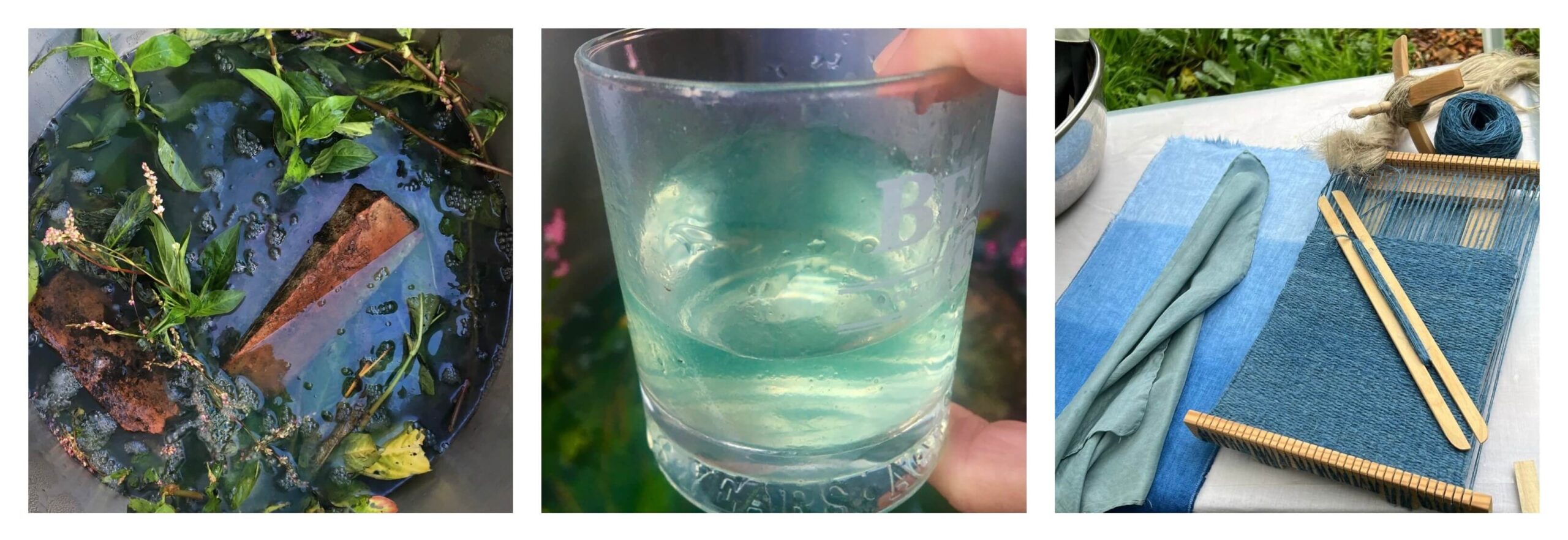
I showed the process of extracting indigo pigment by soaking Persicaria tinctoria leaves to create beautiful mermaid water, then revealed some yarn and cloth that had been dyeing in the Indigo Mother. I also demonstrated the fresh leaf dyeing method that simply involves mashing leaves into cloth. As indigo isn't soluble in water and doesn't become a dye until exposed to oxygen, there were a couple of colourful 'aha' moments as indigo transformed from golden green to blue before our eyes.
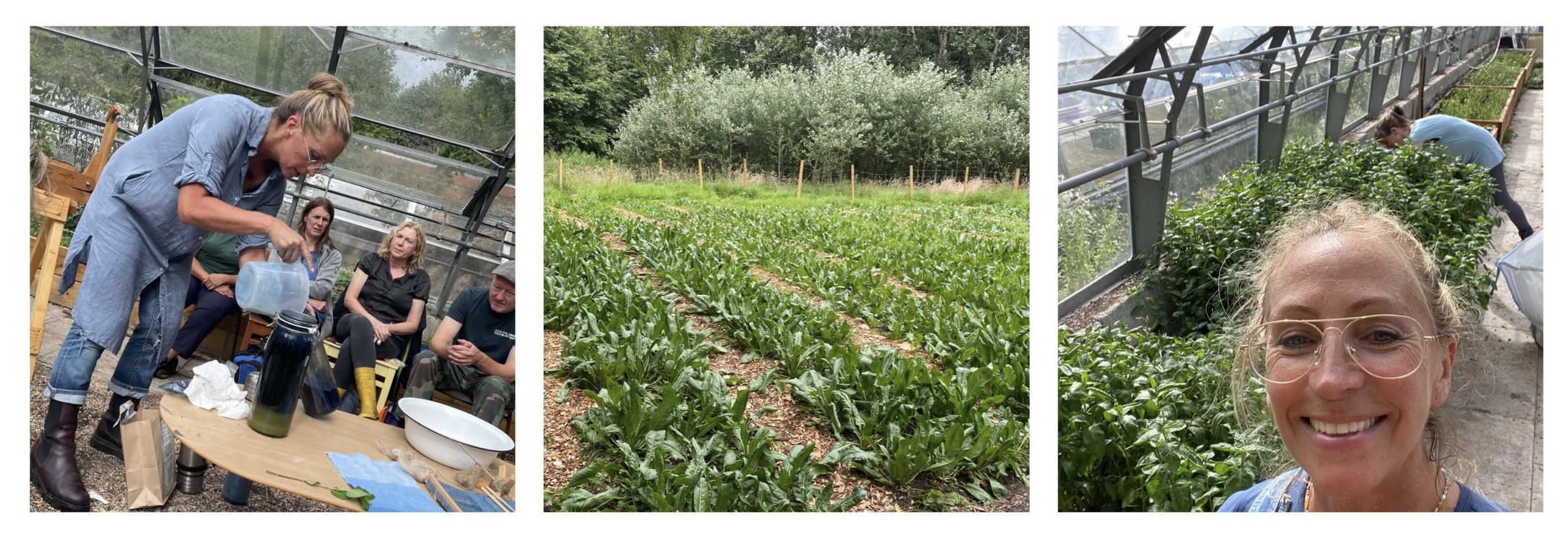
Ground Up and Top Down
My indigo demo for Countryfile took place in the woad field at the Homegrown Homespun project - a disused area of our site we reclaimed last February. I'll talk more about our progress during phase 2 of this 3 year project over on the North West England Fibreshed blog shortly but for now, suffice it to say it was deeply satisfying to see thriving rows of woad (Isatis tinctoria - our native source of indigo) having lost last year's crop to weeds and this represented an enormous amount of work from our stalwart volunteers.
My role on this project is for some hard to define since I'm not only conducting research and making strategic decisions with my project partners but also planning and doing the manual labour every week in the field with our volunteers and this has been crucial as we've experimented to establish an appropriate growing scale. We just about managed this year but at times over-stretched the capacity of our people-power and this has raised many more questions I'll return to but that are beyond the subject of this post.
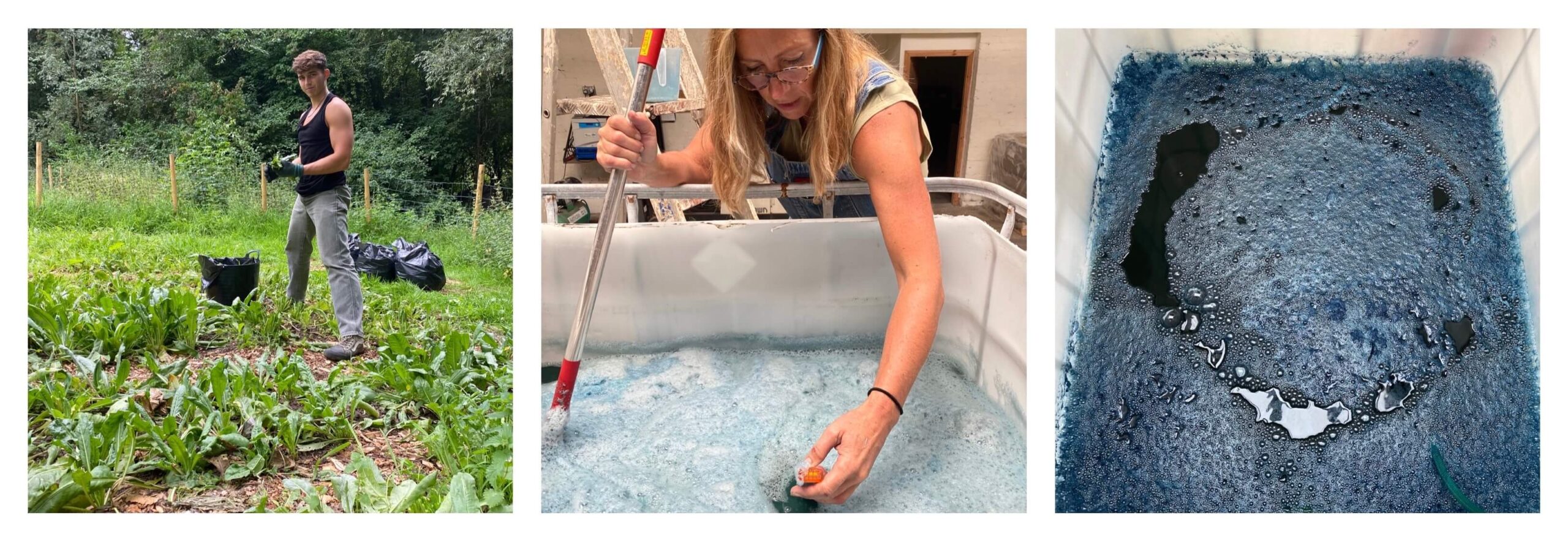
While it may seem like I've been constantly up to my eyes in mud, I've also been working towards the larger aim of our original vision - to get fibre and dye crops growing within the UK agricultural system and create (or incentivise access to) midscale processing facilities to make those crops a viable source of income for farmers.
Part of the purpose of this collaboration was to encourage synthetic dye houses to begin transitioning to locally grown, natural indigo. This would be beneficial to the environment (reducing pollution and regenerating eco-systems), to them (future proofing against the inevitable demise of fossil fuels) and beneficial to the people who've preserved our pre-industrial textile crafts which bridge the gap between farming and fashion. Many textile artisans are restricted from achieving Fibreshed principles because they rely on industrial scale equipment within exclusively synthetic dye factories, making the Fibershed motto, 'local fibres, local dyes and local labour' hard to attain.
Thankfully, Patrick introduced me to Anthony Green of the recently re-opened Yarn Dyers of Blackburn. I'd had a few conversations with retired woad grower Ian Howard who had mentioned dye trails he ran about 20 years ago but it transpired that Anthony had been the apprentice who's first job within a synthetic facility had been using Ian's natural woad! Anthony had all the original recipes and after a lot of R&D (with more still to come) we're at a point where we know our homegrown indigo can dye a cone of yarn within a commercial machine.
Again, I'll expand upon the considerable effort that's gone into this progress over at NWEF but want to say a huge thank you to Anthony for offering his facilities and being open to this experiment. Also pictured below is organic farming consultant and my soon-to-be partner in a larger branch of Fibreshed, Mark Palmer who has caught the indigo bug and put in a huge amount of work helping develop our pigment extraction kit.
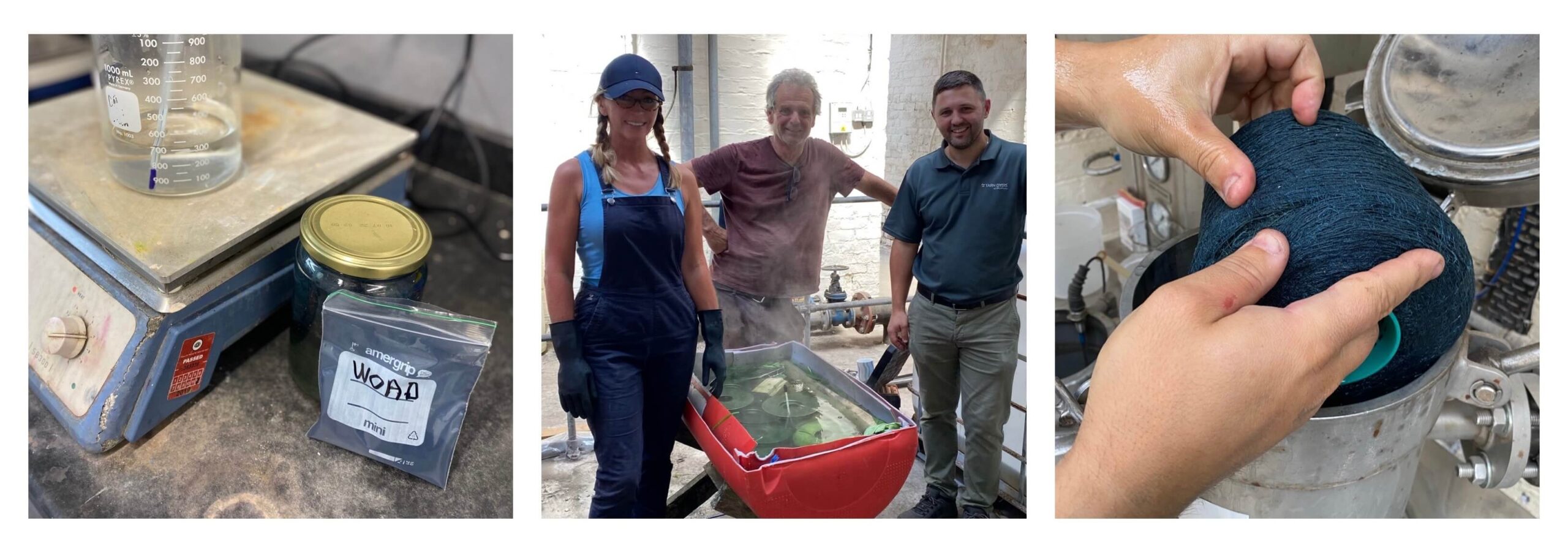
Woman Grows Jeans
I've learnt such a lot since beginning this collaboration and have a lot more lessons to come before it completes in its current iteration in October 2023. What I've noticed is how all eco-activists stand at the threshold of hope and heartbreak - simultaneously holding their visions for a brighter future next to the reality of planetary destruction. This is difficult but as the Earth Logic manifesto states, we must 'stick with the trouble'. To pioneer, you must relinquish expectations and constantly adapt to changing circumstances with compassion for yourself and others.
Compromise is inevitable and can feel like an erosion of integrity but can also open up other creative opportunities to preserve the integrity of an original vision. With all this activity I’d almost forgotten my own dream! So with this in mind, I've realised now is the perfect time to grow the jeans I seeded at my allotment 2 and a half years ago, inspired by Fibershed founder Rebecca Burgess’s 2011 Grow Your Jeans project.
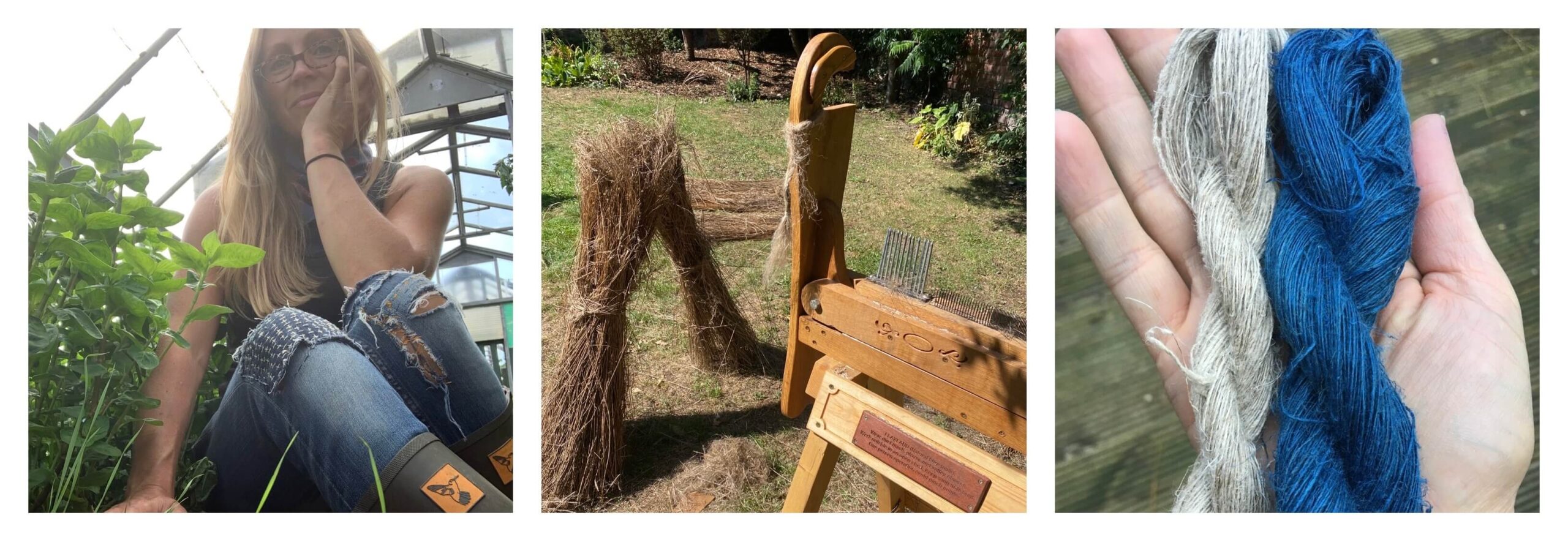
I feel confident we've done enough to bring a small quantity of indigo linen jeans to market via Patrick's social enterprise and this is brilliant! In fact, I'm taking stock of how the perception of natural dyes has changed so quickly and will forever be thankful for his advocacy. It wasn't so long ago business men would tell me how natural dyes were just a niche hobby for middle aged women and totally irrelevant to the fashion industry!
How close these jeans get to Fibershed principles remains to be seen and I'll expand upon this with full disclosure shortly. For now, I'm holding my vision of what we aimed for last year, one pair made by hand, showing the beautiful struggle and whispering with the ancestral muscle memories invoked during the making process. As I’m new to spinning and weaving, I won’t be able to accomplish the standard of work these masters produced but however they manifest, these jeans will adhere to the highest Fibershed principles possible - and goodness knows I need a new pair of jeans! (See above!) You can follow my progress using the hashtag #WomanGrowsJeans
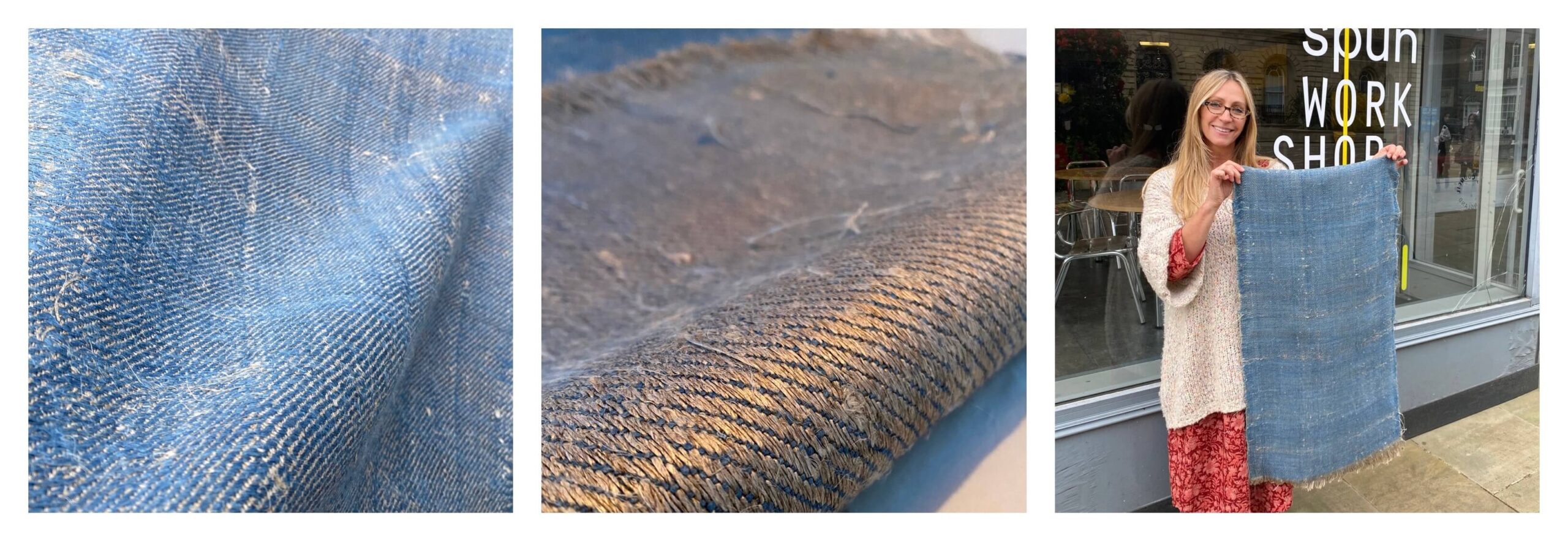
Growing Slow Textiles
There are deeper implications to regenerative practice that I've been exploring with a wonderful group of people taking part in my Growing Slow Textiles course this year. It's been incredibly rewarding to watch people transform seed into coloured yarn and eventually cloth and I know we're on to something important that I now need to explore more deeply through my own personal textile practice. If you’d like to join my 2023 class you can add yourself to the waiting list by emailing via the contact page
Humans grew their own clothing for around 1194 generations. Only the last 6 generations haven't.
Spinning, weaving and natural dyeing speak from a time before ecocide when people had more time and did less harm. Why were our ancestors empowered with the time and skill to grow their own clothing sustainably when we’re reliant upon fast fashion proven to cause social and environmental harm? Next year I will work the way our indigenous ancestors did to fully embody principles that are otherwise in danger of being reduced to just another greenwash USP.
I’ve set myself the seemingly impossible challenge of growing, processing, hand spinning, weaving and sewing my own pair of jeans. I’m going to make these jeans a meditation and hope they will help express an important element of this story at next October’s British Textile Biennial. I’m dreaming of 101 pairs - 100 commercially produced by Patrick and one by me. That would be a dream come true.
You can watch the ‘Field to Fashion’ episode of BBC1’s Countryfile this Sunday at 5:15pm.
“The Earth gives everything for free. Humans are the only species who pay to live here.” - Clare Dubois, TreeSisters Founder
*Rebecca Burgess compared the capitalist obsession with growth to the Buddhist concept of ‘hungry ghosts’ in her first brilliant podcast with the economist Jason Hickel. Listen here.





